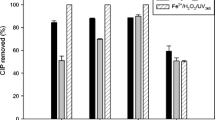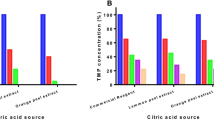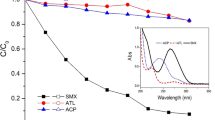Abstract
This study evaluates the treatment of the antibiotic cloxacillin (CLX) in water by means of electrochemical oxidation, TiO2 photocatalysis, and the photo-Fenton system. The three treatments completely removed cloxacillin and eliminated the residual antimicrobial activity from synthetic pharmaceutical wastewater containing the antibiotic, commercial excipients, and inorganic ions. However, significant differences in the degradation routes were found. In the photo-Fenton process, the hydroxyl radical was involved in the antibiotic removal, while in the TiO2 photocatalysis process, the action of both the holes and the adsorbed hydroxyl radicals degraded the pollutant. In the electrochemical treatment (using a Ti/IrO2 anode in sodium chloride as supporting electrolyte), oxidation via HClO played the main role in the removal of CLX. The analysis of initial by-products showed five different mechanistic pathways: oxidation of the thioether group, opening of the central β-lactam ring, breakdown of the secondary amide, hydroxylation of the aromatic ring, and decarboxylation. All the oxidation processes exhibited the three first pathways. Moreover, the aromatic ring hydroxylation was found in both photochemical treatments, while the decarboxylation of the pollutant was only observed in the TiO2 photocatalysis process. As a consequence of the degradation routes and mechanistic pathways, the elimination of organic carbon was different. After 480 and 240 min, the TiO2 photocatalysis and photo-Fenton processes achieved ∼45 and ∼15 % of mineralization, respectively. During the electrochemical treatment, 100 % of the organic carbon remained even after the antibiotic was treated four times the time needed to degrade it. In contrast, in all processes, a natural matrix (mineral water) did not considerably inhibit pollutant elimination. However, the presence of glucose in the water significantly affected the degradation of CLX by means of TiO2 photocatalysis.






Similar content being viewed by others
References
Bouki C, Venieri D, Diamadopoulos E (2013) Detection and fate of antibiotic resistant bacteria in wastewater treatment plants: a review. Ecotoxicol Environ Saf 91:1–9. doi:10.1016/j.ecoenv.2013.01.016
Cha JM, Yang S, Carlson KH (2006) Trace determination of beta-lactam antibiotics in surface water and urban wastewater using liquid chromatography combined with electrospray tandem mass spectrometry. J Chromatogr A 1115:46–57. doi:10.1016/j.chroma.2006.02.086
Chen Y, Yang S, Wang K, Lou L (2005) Role of primary active species and TiO2 surface characteristic in UV-illuminated photodegradation of Acid Orange 7. J Photochem Photobiol A Chem 172:47–54. doi:10.1016/j.jphotochem.2004.11.006
Clayden J, Greeves N, Warren S, Wothers P (2001) Electrophilic aromatic substitution. In: New York O (ed) Organic chemistry, First. Oxford University Press, New York, pp 547–579
Comninelis C, Chen G (2010) Electrochemistry for the environment. Springer, London
Dail MK, Mezyk SP (2010) Hydroxyl-radical-induced degradative oxidation of β-lactam antibiotics in water: absolute rate constant measurements. J Phys Chem A 114:8391–8395
Deborde M, von Gunten U (2008) Reactions of chlorine with inorganic and organic compounds during water treatment—kinetics and mechanisms: a critical review. Water Res 42:13–51. doi:10.1016/j.watres.2007.07.025
Devi LG, Raju KSA, Kumar SG, Rajashekhar KE (2011) Photo-degradation of di azo dye Bismarck Brown by advanced photo-Fenton process: Influence of inorganic anions and evaluation of recycling efficiency of iron powder. J Taiwan Inst Chem Eng 42:341–349. doi:10.1016/j.jtice.2010.05.010
Dimitrakopoulou D, Rethemiotaki I, Frontistis Z et al (2012) Degradation, mineralization and antibiotic inactivation of amoxicillin by UV-A/TiO2 photocatalysis. J Environ Manag 98:168–174. doi:10.1016/j.jenvman.2012.01.010
Dodd MC, Huang CH (2004) Transformation of the antibacterial agent sulfamethoxazole in reactions with chlorine: kinetics, mechanisms, and pathways. Environ Sci Technol 38:5607–5615. doi:10.1021/es035225z
Elmolla E, Chaudhuri M (2009a) Optimization of Fenton process for treatment of amoxicillin, ampicillin and cloxacillin antibiotics in aqueous solution. J Hazard Mater 170:666–672
Elmolla ES, Chaudhuri M (2009b) Degradation of the antibiotics amoxicillin, ampicillin and cloxacillin in aqueous solution by the photo-Fenton process. J Hazard Mater 172:1476–1481. doi:10.1016/j.jhazmat.2009.08.015
Elmolla ES, Chaudhuri M (2010) Degradation of amoxicillin, ampicillin and cloxacillin antibiotics in aqueous solution by the UV/ZnO photocatalytic process. J Hazard Mater 173:445–449
Giraldo AL, Erazo-Erazo ED, Flórez-Acosta OA et al (2015) Degradation of the antibiotic oxacillin in water by anodic oxidation with Ti/IrO2 anodes: evaluation of degradation routes, organic by-products and effects of water matrix components. Chem Eng J 279:103–114. doi:10.1016/j.cej.2015.04.140
Giraldo-Aguirre AL, Erazo-Erazo ED, Flórez-Acosta OA et al (2015) TiO2 photocatalysis applied to the degradation and antimicrobial activity removal of oxacillin: evaluation of matrix components, experimental parameters, degradation pathways and identification of organics by-products. J Photochem Photobiol A Chem 311:95–103. doi:10.1016/j.jphotochem.2015.06.021
Guzmán-Duque FL, Palma-Goyes RE, González I et al (2014) Relationship between anode material, supporting electrolyte and current density during electrochemical degradation of organic compounds in water. J Hazard Mater 278:221–226. doi:10.1016/j.jhazmat.2014.05.076
He X, Mezyk SP, Michael I et al (2014) Degradation kinetics and mechanism of β-lactam antibiotics by the activation of H2O2 and Na2S2O8 under UV-254nm irradiation. J Hazard Mater 279:375–383
Homem V, Santos L (2011) Degradation and removal methods of antibiotics from aqueous matrices—a review. J Environ Manag 92:2304–2347. doi:10.1016/j.jenvman.2011.05.023
Houas A, Lachheb H, Ksibi M, et al. (2001) Photocatalytic degradation pathway of methylene blue in water. Appl Catal B Environ 31:145–157
Ito Y, Ikai Y, Oka H et al (2001) Application of ion-exchange cartridge clean-up in food analysis IV. Confirmatory assay of benzylpenicillin, phenoxymethylpenicillin, oxacillin, cloxacillin, nafcillin and dicloxacillin, in bovine tissues by liquid chromatography-electrospray ionization tandem mass spectrometry. J Chromatogr A 911:217–223. doi:10.1016/S0021-9673(01)00512-X
Konaklieva M (2014) Molecular Targets of β-Lactam-Based Antimicrobials: Beyond the Usual Suspects. Antibiotics 3:128–142. doi:10.3390/antibiotics3020128
Kumar A, Mathur N (2006) Photocatalytic degradation of aniline at the interface of TiO2 suspensions containing carbonate ions. J Colloid Interface Sci 300:244–252. doi:10.1016/j.jcis.2006.03.046
Kümmerer K (2009) Antibiotics in the aquatic environment—a review—Part II. Chemosphere 75:435–441. doi:10.1016/j.chemosphere.2008.12.006
Mavronikola C, Demetriou M, Hapeshi E et al (2009) Mineralisation of the antibiotic amoxicillin in pure and surface waters by artificial UVA- and sunlight-induced fenton oxidation. J Chem Technol Biotechnol 84:1211–1217. doi:10.1002/jctb.2159
Mazellier P, Busset C, Delmont A, De Laat J (2007) A comparison of fenuron degradation by hydroxyl and carbonate radicals in aqueous solution. Water Res 41:4585–4594. doi:10.1016/j.watres.2007.06.066
Michael I, Rizzo L, McArdell CS et al (2013) Urban wastewater treatment plants as hotspots for the release of antibiotics in the environment: a review. Water Res 47:957–995. doi:10.1016/j.watres.2012.11.027
Neamţu M, Grandjean D, Sienkiewicz A et al (2014) Degradation of eight relevant micropollutants in different water matrices by neutral photo-Fenton process under UV254 and simulated solar light irradiation—a comparative study. Appl Catal B Environ 158–159:30–37. doi:10.1016/j.apcatb.2014.04.001
Ohtani B (2014) Revisiting the fundamental physical chemistry in heterogeneous photocatalysis: its thermodynamics and kinetics. Phys Chem Chem Phys 16:1788–1797. doi:10.1039/c3cp53653j
Palominos R, Freer J, Mondaca MA, Mansilla HD (2008) Evidence for hole participation during the photocatalytic oxidation of the antibiotic flumequine. J Photochem Photobiol A Chem 193:139–145. doi:10.1016/j.jphotochem.2007.06.017
Palominos RA, Mondaca MA, Giraldo A, et al (2009) Photocatalytic oxidation of the antibiotic tetracycline on TiO2 and ZnO suspensions. Catal Today 144:100–105. doi:10.1016/j.cattod.2008.12.031
Panizza M, Cerisola G (2009) Direct and mediated anodic oxidation of organic pollutants. Chem Rev 109:6541–6569. doi:10.1021/cr9001319
Pereira JHOS, Reis AC, Queirós D et al (2013) Insights into solar TiO2-assisted photocatalytic oxidation of two antibiotics employed in aquatic animal production, oxolinic acid and oxytetracycline. Sci Total Environ 463–464:274–283. doi:10.1016/j.scitotenv.2013.05.098
Pignatello JJ, Oliveros E, Mackay A (2006) Advanced oxidation processes for organic contaminant destruction based on the Fenton reaction and related chemistry. Crit Rev Environ Sci Technol 36:1–84. doi:10.1080/10643380500326564
Rivera-Utrilla J, Sánchez-Polo M, Ferro-García MÁ et al (2013) Pharmaceuticals as emerging contaminants and their removal from water. A review. Chemosphere 93:1268–1287. doi:10.1016/j.chemosphere.2013.07.059
Santiago DE, Araña J, González-Díaz O, et al (2014) Effect of inorganic ions on the photocatalytic treatment of agro-industrial wastewaters containing imazalil. Appl Catal B Environ 156-157:284–292. doi:10.1016/j.apcatb.2014.03.022
Serna-Galvis EA, Silva-Agredo J, Giraldo AL et al (2016a) Comparison of route, mechanism and extent of treatment for the degradation of a β-lactam antibiotic by TiO2 photocatalysis, sonochemistry, electrochemistry and the photo-Fenton system. Chem Eng J 284:953–962. doi:10.1016/j.cej.2015.08.154
Serna-Galvis EA, Silva-Agredo J, Giraldo AL et al (2016b) Comparative study of the effect of pharmaceutical additives on the elimination of antibiotic activity during the treatment of oxacillin in water by the photo-Fenton, TiO2-photocatalysis and electrochemical processes. Sci Total Environ 541:1431–1438. doi:10.1016/j.scitotenv.2015.10.029
Serna-Galvis EA, Silva-Agredo J, Giraldo-Aguirre AL, Torres-Palma RA (2015) Sonochemical degradation of the pharmaceutical fluoxetine: effect of parameters, organic and inorganic additives and combination with a biological system. Sci Total Environ 524–525:354–360. doi:10.1016/j.scitotenv.2015.04.053
Sirés I, Brillas E (2012) Remediation of water pollution caused by pharmaceutical residues based on electrochemical separation and degradation technologies: a review. Environ Int 40:212–229. doi:10.1016/j.envint.2011.07.012
Song W, Chen W, Cooper WJ et al (2008) Free-radical destruction of beta-lactam antibiotics in aqueous solution. J Phys Chem A 112:7411–7417. doi:10.1021/jp803229a
Sopaj F, Rodrigo MA, Oturan N et al (2015) Influence of the anode materials on the electrochemical oxidation efficiency. Application to oxidative degradation of the pharmaceutical amoxicillin. Chem Eng J 262:286–294. doi:10.1016/j.cej.2014.09.100
Sutherland R, Croydon EAP, Rolinson GN (1970) Flucloxacillin, a new isoxazolyl penicillin, compared with oxacillin, cloxacillin, and dicloxacillin. Br Med J 4:455–460
Thomm E, Wayman M (1969) N-Chlorination of secondary amides. Can J Chem 47:3289–3297
Villegas-Guzman P, Silva-Agredo J, Giraldo-Aguirre AL et al (2015a) Enhancement and inhibition effects of water matrices during the sonochemical degradation of the antibiotic dicloxacillin. Ultrason Sonochem 22:211–219. doi:10.1016/j.ultsonch.2014.07.006
Villegas-Guzman P, Silva-Agredo J, González-Gómez D et al (2015b) Evaluation of water matrix effects, experimental parameters, and the degradation pathway during the TiO2 photocatalytical treatment of the antibiotic dicloxacillin. J Environ Sci Health A Toxicol Hazard Subst Environ Eng 50:40–48. doi:10.1080/10934529.2015.964606
Zhang G, He X, Nadagouda MN et al (2015) The effect of basic pH and carbonate ion on the mechanism of photocatalytic destruction of cylindrospermopsin. Water Res 73:353–361. doi:10.1016/j.watres.2015.01.011
Acknowledgments
The authors would like to thank Colciencias and to the Swiss National Foundation for the financial support to this study within the projects: “Implementación de metodologías eficientes y confiables para degradar residuos de antimicrobianos en el hogar y en efluentes industriales” and “Treatment of the hospital wastewaters in Cote d’Ivoire and in Colombia by advanced oxidation processes,” respectively.
Author information
Authors and Affiliations
Corresponding author
Additional information
Responsible editor: Bingcai Pan
Rights and permissions
About this article
Cite this article
Serna-Galvis, E.A., Giraldo-Aguirre, A.L., Silva-Agredo, J. et al. Removal of antibiotic cloxacillin by means of electrochemical oxidation, TiO2 photocatalysis, and photo-Fenton processes: analysis of degradation pathways and effect of the water matrix on the elimination of antimicrobial activity. Environ Sci Pollut Res 24, 6339–6352 (2017). https://doi.org/10.1007/s11356-016-6257-5
Received:
Accepted:
Published:
Issue Date:
DOI: https://doi.org/10.1007/s11356-016-6257-5




